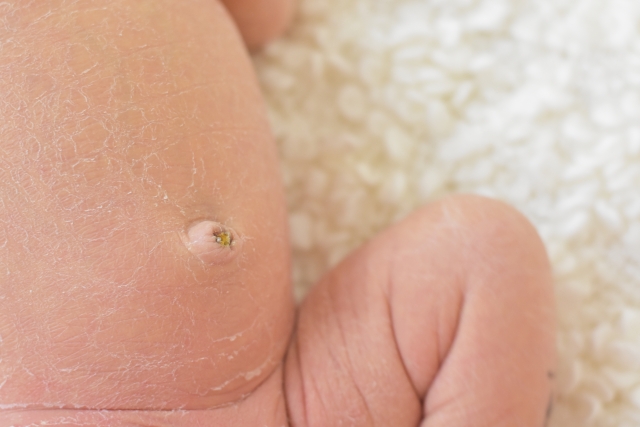Summary of this article
This article describes parent-child identification using the umbilical cord. The umbilical cord contains the baby's DNA, and if well preserved, the parent-child relationship can be confirmed even years later. It is a non-invasive method, and samples taken immediately after birth can be used for accurate identification. It is also a reliable method that can be used in legal proceedings, but requires attention to preservation and sample quality. This section discusses the appraisal process, advantages, and legal uses.
Possibility of parent-child identification using umbilical cord
In recent years, advances in DNA testing technology have greatly increased the means of confirming parent-child relationships.Among these, a somewhat unique method of paternity testing using the umbilical cord has been attracting attention. The umbilical cord, a symbol that connects the newborn to the mother’s body, contains the baby’s DNA, which can be used to prove the parent-child relationship. This article details the mechanics and advantages of parent-child identification using the umbilical cord, as well as the actual procedure.
What is paternity test using umbilical cord?
The umbilical cord, which is cut at birth, is an important organ that physically connects the baby to the mother. The cord and placenta are rich in the baby’s DNA, which can be used to confirm the parent-child relationship.
While the most popular method of paternity testing is the “oral swab,” in which DNA is collected from the inside of the cheek, testing using the umbilical cord is particularly effective when a DNA sample remains from the time of birth. Let’s take a look at the process of how paternity testing using the umbilical cord is performed.
The process of DNA analysis from the umbilical cord
The basic flow of a paternity test using an umbilical cord is almost the same as that of a regular DNA test. However, there are several important points in that a special sample, the umbilical cord, is used.
1. preservation of the umbilical cord
The umbilical cord is usually cut soon after birth. Many families have a culture of drying and preserving the umbilical cord. In Japan, it is customary to preserve the umbilical cord as a keepsake, which can later be used for paternity testing. If the umbilical cord is properly dried and preserved, DNA can be extracted even several years later and can be used as a sufficient sample for paternity testing.
However, poor storage conditions or failure to properly store the DNA over a long period of time can lead to further deterioration of the DNA. Therefore, it is important to establish proper storage methods as early as possible. Even dried umbilical cords often contain sufficient amounts of DNA for analysis, and in many cases, reliable results can be obtained even with long storage periods.
2. stability of DNA
The DNA contained in the umbilical cord is the same as the DNA contained in the baby’s other body tissues.In other words, DNA extracted using the umbilical cord is just as accurate in confirming paternity as DNA taken from the inside of the cheek.For this reason, paternity testing using the umbilical cord is performed with the same level of accuracy as regular paternity testing.
In addition, the umbilical cord may contain DNA from the baby as well as DNA from the mother’s tissue. Therefore, when using the umbilical cord, a separate sample from the mother can be provided to further enhance the accuracy of the identification.
3. appraisal procedures
The procedure for a paternity test using an umbilical cord is basically the same as for any other DNA test. First, a sample of the umbilical cord is submitted to an appraiser. After the sample is taken, it is compared to the DNA sample of the father or mother to confirm the parent-child relationship.
DNA extraction from umbilical cords requires specialized techniques. Especially when used as legal evidence, the samples must be handled under strict control and according to formal protocols. Properly performed, this procedure provides reliable results that can be used as evidence in courts of law.
Advantages of using the umbilical cord for paternity testing
Paternity testing using the umbilical cord offers several unique advantages. In particular, it offers the following advantages over traditional DNA testing methods
1. sample available immediately after birth
Because the umbilical cord is a DNA sample taken shortly after the baby’s birth, it is especially useful for confirming the parent-child relationship shortly after the baby’s birth. For example, if you keep the umbilical cord taken at the hospital soon after birth, it is very useful for later confirmation of the parent-child relationship.
In addition, if there is doubt about the parent-child relationship after the baby has grown up, the use of the umbilical cord preserved in the past makes it possible to test the baby based on DNA from the time of birth, thus providing highly reliable results.

2. non-invasive
Paternity testing using the umbilical cord is a non-invasive method in that it does not require new sample collection for the baby or parents. Because it utilizes an already preserved umbilical cord, the test can be performed without additional pain or strain. This method is especially useful for young children and babies when new sampling is to be avoided.
Legal Use of Umbilical Cord Paternity Tests
Paternity testing using the umbilical cord can be used in legal proceedings. However, there are several conditions that must be met before it can be used as a legal expert test. In order to be submitted to the court, it is important that the appraisal is done through proper procedures and that the sample is strictly controlled.
For example, evidence regarding the handling of the sample is needed, such as how the umbilical cord sample was stored, who provided it, and how it was sent to the authenticating agency. If these procedures are followed properly, they can be used as legally valid evidence.
In legal appraisals, a detailed report is prepared by the appraiser and used as evidence for submission to the court.This report details how the samples were taken, how they were managed, and the results of the appraisal, and is often used in custody disputes and inheritance matters.
Cautions in Umbilical Cord Appraisal
There are some caveats to paternity testing using the umbilical cord.
1. check preservation status
If the umbilical cord has been stored for a long period of time, the DNA may have deteriorated depending on the storage conditions.It is important to confirm that the condition of storage is good, as the quality of DNA may change depending on the drying conditions and the environment of the storage location.
2. accuracy of appraisal results
The accuracy of an appraisal using the umbilical cord is very high, as is the accuracy of a normal paternity test, but if the sample is of poor quality, the accuracy of the results may be affected.If the sample is in poor condition, additional samples may be required.
Summary
Paternity testing using the umbilical cord is more reliable than conventional methods, especially when samples taken at birth are later used It is a very convenient method because it is non-invasive and allows DNA testing to be performed without placing a burden on the baby or the parents.
It can also be used appropriately in legal proceedings and can be used to address legal issues such as custody disputes and inheritance problems. If you are considering a paternity test using the umbilical cord, we recommend that you consult with an appraiser and proceed with the appropriate procedures.
Latest Articles
Supervisor of the article

Dr. Hiroshi Oka
Graduated from Keio University, Faculty of Medicine
Doctor of Medicine
Medical Doctor









